Italian diva Francesca Bertini played the title role in Frou-Frou (1918), adapted from a play by Henri Meilhac and Ludovic Halévy. The remarkable cards in this post Spanish collectors cards were published by Chocolat Imperiale, and the photos were made by Pinto in Rome for Caesar Film .
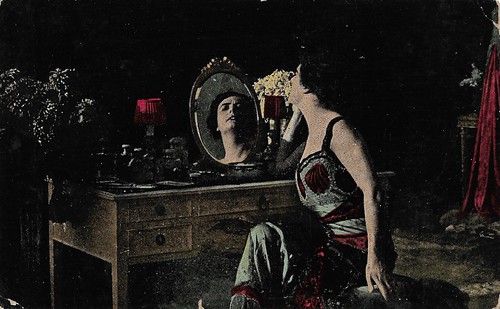
Spanish collectors card by Chocolat Imperiale, no. 1. Photo: Pinto, Roma / Caesar Film. Francesca Bertini in Frou-Frou (Alfredo De Antoni, 1918).

Spanish collectors card by Chocolat Imperiale, no. 2. Photo: Pinto, Roma / Caesar Film. Francesca Bertini and Guido Trento in Frou-Frou (Alfredo De Antoni, 1918).

Spanish collectors card by Chocolat Imperiale', no. 3. Photo: Pinto, Roma / Caesar Film. Francesca Bertini in Frou-Frou (Alfredo De Antoni, 1918).
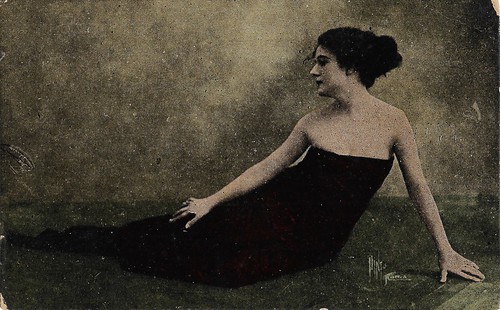
Spanish collectors card by Chocolat Imperiale', no. 4. Photo: Pinto, Roma / Caesar Film. Francesca Bertini in Frou-Frou (Alfredo De Antoni, 1918).

Spanish collectors card by Chocolat Imperiale', no. 5. Photo: Pinto, Roma / Caesar Film. Francesca Bertini and Guido Trento in Frou-Frou (Alfredo De Antoni, 1918).

Spanish collectors card by Chocolat Imperiale', no. 6. Photo: Pinto, Roma / Caesar Film. Francesca Bertini and Cia Fornaroli in Frou-Frou (Alfredo De Antoni, 1918).
Francesca Bertini plays in Frou-Frou (Alfredo De Antoni, 1918) Gilberte 'Frou Frou' Sartorys, a beautiful but rather heedless young woman. She is bored by her quiet life with Count Henri Sartorys (Gustavo Serena), a brilliant but calm and phlegmatic diplomat. She is also indifferent to her little son Georges.
So she starts a flirt with a depraved aristocrat, Count Paul de Valréas (Guido Trento). Paul convinces Gilberte to bring her somber sister Louise (Cia Fornaroli) into the household, so she has more time for herself. Moreover, Louise is secretly in love with Henri. Louise quickly assumes the direction of Henri's home and innocently supplants Frou Frou in the eyes of her husband and child.
Sensing that her presence is no longer needed at the Sartorys estate, Frou Frou bitterly denounces Louise and then elopes with Paul to Venice. When the husband finds out about the adultery, he challenges the rival to a duel and kills him. He chases the supposedly faithless wife too.
One year after, she who once was rich and beautiful, is reduced to poverty and lies dying in a small bed in Venice. Louise finds her and summons Henri and Georges. She implores and receives the pardon of her husband, in whose arms she serenely breathes her last breath.
Frou-Frou premiered in Rome on 10 May 1918. The cinematography was by Alberto Carta and sets by Alfredo Manzi. In addition to Bertini, Serena, Fornaroli and Trento, other actors were Franco Gennaro (Gilberte's father), and Alfredo De Antoni, while we recognised also Olga Benetti on one of our cards.

Spanish collectors card by Chocolat Imperiale, no. 7. Photo: Pinto, Roma / Caesar Film. Francesca Bertini in Frou-Frou (Alfredo De Antoni, 1918).

Spanish collectors card by Chocolat Imperiale', no. 8. Photo: Pinto, Roma / Caesar Film. Francesca Bertini and Gustavo Serena in Frou-Frou (Alfredo De Antoni, 1918).

Spanish collectors card by Chocolat Imperiale, no. 9. Photo: Pinto, Roma / Caesar Film. Francesca Bertini and Gustavo Serena in Frou-Frou (Alfredo De Antoni, 1918).

Spanish collectors card by Chocolat Imperiale no. 10. Photo: Pinto, Roma / Caesar Film. Guido Trento and Olga Benetti in Frou-Frou (Alfredo De Antoni, 1918).

Spanish collectors card by Chocolat Imperiale, no. 11. Photo: Pinto, Roma / Caesar Film. Francesca Bertini in Frou-Frou (Alfredo De Antoni, 1918).

Spanish collectors card by Chocolat Imperiale, no. 12. Photo: Pinto, Roma / Caesar Film. Francesca Bertini, Cia Fornaroli and Gustavo Serena in Frou-Frou (Alfredo De Antoni, 1918).
The Italian press was not very impressed by Frou-Frou (Alfredo De Antoni, 1918). Bertoldo wrote in the Turinese trade journal La vita cinematografica in 1919 that Bertini's beauty and elegance had suffocated any other artistic element, so the film looked more like a fashion show. "The actress goes around with the impassibility and certainty of a mannequin."
Instead, the French critic Louis Delluc, when raving about Bertini in his articles in the late 1910s and early 1920s, often mentioned this film too, in addition to La signora dalle camelie, Fedora, Tosca, and others.
Also, when the film was shown in Barcelona, a critic with the pseudonym Colombine wrote (cited at Sempre in penombra): "She is more than a woman an embodiment of the pain of her time because always the myth and the legend embodied the pain in figures of women. Bertini is a woman who suffers a lot, who suffers excessively, who falls under the weight of suffering. It touches us more because she suffers with a face so delicate, so soft, of such a dramatic dramatic profile, that pain is primed in its beauty.
Truly, Bertini's face knows how to reveal the most distinguished pain, with the purest features, and, contemplating it, she thinks with fear of the voluptuousness of the crowds who see her suffer as if falling apart under a rough caress that kisses her, tormenting her. It enjoys getting excited to see her faint, more beautiful in those lazy and languid expressions of pain for which she prepares so much, wearing black dresses, which become her suffering figure so well, and those dresses which sharpen her necklines; as if her necklines made suffering more seductive.
{...} She offers herself in her films such that it is as if she were offering herself multiplied, making an impossible effort, so that the film shows are celebrated with the amount of relief for the fate of the wounded, the widows and the orphans. One of these sessions, given in Rome, has had the interest of attending Bertini in person. The public has been able to verify the reality, see the relief and the life of the woman who is presented as something unreal, as an enigma to the near and distant couple.
After contemplating her in the darkness of the auditorium her rare duplicity, her unfolding, of seeing herself as alien to herself, she has been applauded deliriously. The newspapers say that Bertini "greeted with tears in the eyes" that audience that was moved, engaged in war, who came to the call of charity, and that perhaps did not applaud Bertini, but all the soul she had given to those other women who lived from her life, detached from her in the progression of the cinematograph."

Spanish collectors card by Chocolat Imperiale', no. 13. Photo: Pinto, Roma / Caesar Film. Francesca Bertini in Frou-Frou (Alfredo De Antoni, 1918).
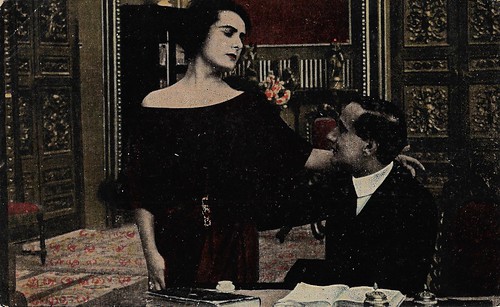
Spanish collectors card by Chocolat Imperiale', no. 14. Photo: Pinto, Roma / Caesar Film. Francesca Bertini and Gustavo Serena in Frou-Frou (Alfredo De Antoni, 1918).

Spanish collectors card by Chocolat Imperiale', no. 15. Photo: Pinto, Roma / Caesar Film. Francesca Bertini in Frou-Frou (Alfredo De Antoni, 1918).
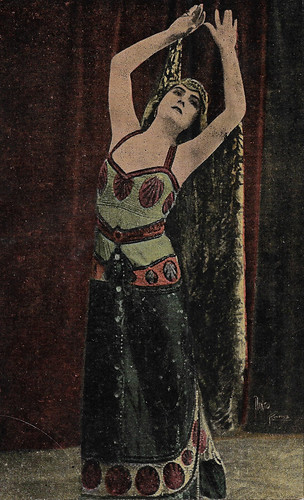
Spanish collectors card by Chocolat Imperiale', no. 16. Photo: Pinto, Roma / Caesar Film. Francesca Bertini in Frou-Frou (Alfredo De Antoni, 1918).

Spanish collectors card by Chocolat Imperiale', no. 17. Photo: Pinto, Roma / Caesar Film. Francesca Bertini in Frou-Frou (Alfredo De Antoni, 1918).
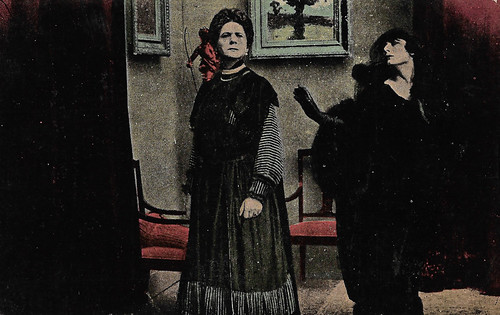
Spanish collectors card by Chocolat Imperiale', no. 18. Photo: Pinto, Roma / Caesar Film. Francesca Bertini in Frou-Frou (Alfredo De Antoni, 1918).
The play Frou-Frou (1869) by Henri Meilhac and Ludovic Halévy was often adapted to film: in 1914, 1924, 1918 and 1938. Other films called Frou-Frou were not based on the play, such as editions of 1913 and 1955.
Before being adapted to the cinema, Frou-Frou had been an important play for both Sarah Bernhardt and Eleonora Duse. Theatre critic Richard Nathanson, who had seen the performances of Frou-Frou by both actresses, was convinced Duse was better than Bernhardt, because of her capabilities to interiorise.
On Bernhardt's performance, he wrote in his book 'Schauspieler und Theater im heutigen Italien' (1893): "The words came out as they can to adequately pronounce only one virtuoso of the scene, but the soul, the more inner human nature that wanted to manifest itself, that did not come out."
Instead, on Duse's performance of the crucial scene in which Frou-Frou settles accounts with her sister, he wrote: "The figure grew imposingly; glowing and burning sparks burst from her eyes; her chest rose and fell, as if she were working in a volcano, and therefore broke the torrent of speech from the lips - lips on which she had flinched - like lava that overwhelmed with herself everything, powerful, sudden, hitting mortally."
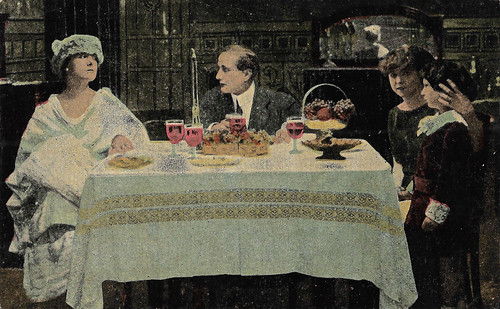
Spanish collectors card by Chocolat Imperiale', no. 19. Photo: Pinto, Roma / Caesar Film. Francesca Bertini, Cia Fornaroli and Gustavo Serena in Frou-Frou (Alfredo De Antoni, 1918).

Spanish collectors card by Chocolat Imperiale', no. 20. Photo: Pinto, Roma / Caesar Film. Francesca Bertini, Cia Fornaroli and Gustavo Serena in Frou-Frou (Alfredo De Antoni, 1918).

Spanish collectors card by Chocolat Imperiale', no. 21. Photo: Pinto, Roma / Caesar Film. Francesca Bertini in Frou-Frou (Alfredo De Antoni, 1918).

Spanish collectors card by Chocolat Imperiale', no. 22. Photo: Pinto, Roma / Caesar Film. Francesca Bertini>, Cia Fornaroli and Gustavo Serena in Frou-Frou (Alfredo De Antoni, 1918).

Spanish collectors card by Chocolat Imperiale', no. 23. Photo: Pinto, Roma / Caesar Film. Francesca Bertini in Frou-Frou (Alfredo De Antoni, 1918).
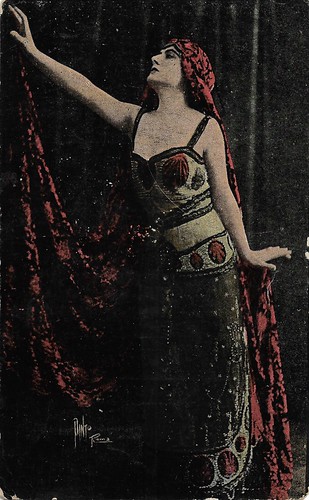
Spanish collectors card by Chocolat Imperiale', no. 24. Photo: Pinto, Roma / Caesar Film. Francesca Bertini in Frou-Frou (Alfredo De Antoni, 1918).
Sources: Sempre in penombra (Italian), Acting Archives Review (Italian), Wikipedia (Italian) and IMDb.

Spanish collectors card by Chocolat Imperiale, no. 1. Photo: Pinto, Roma / Caesar Film. Francesca Bertini in Frou-Frou (Alfredo De Antoni, 1918).

Spanish collectors card by Chocolat Imperiale, no. 2. Photo: Pinto, Roma / Caesar Film. Francesca Bertini and Guido Trento in Frou-Frou (Alfredo De Antoni, 1918).

Spanish collectors card by Chocolat Imperiale', no. 3. Photo: Pinto, Roma / Caesar Film. Francesca Bertini in Frou-Frou (Alfredo De Antoni, 1918).

Spanish collectors card by Chocolat Imperiale', no. 4. Photo: Pinto, Roma / Caesar Film. Francesca Bertini in Frou-Frou (Alfredo De Antoni, 1918).

Spanish collectors card by Chocolat Imperiale', no. 5. Photo: Pinto, Roma / Caesar Film. Francesca Bertini and Guido Trento in Frou-Frou (Alfredo De Antoni, 1918).

Spanish collectors card by Chocolat Imperiale', no. 6. Photo: Pinto, Roma / Caesar Film. Francesca Bertini and Cia Fornaroli in Frou-Frou (Alfredo De Antoni, 1918).
Serenely breathing her last breath in hr husband's arms
Francesca Bertini plays in Frou-Frou (Alfredo De Antoni, 1918) Gilberte 'Frou Frou' Sartorys, a beautiful but rather heedless young woman. She is bored by her quiet life with Count Henri Sartorys (Gustavo Serena), a brilliant but calm and phlegmatic diplomat. She is also indifferent to her little son Georges.
So she starts a flirt with a depraved aristocrat, Count Paul de Valréas (Guido Trento). Paul convinces Gilberte to bring her somber sister Louise (Cia Fornaroli) into the household, so she has more time for herself. Moreover, Louise is secretly in love with Henri. Louise quickly assumes the direction of Henri's home and innocently supplants Frou Frou in the eyes of her husband and child.
Sensing that her presence is no longer needed at the Sartorys estate, Frou Frou bitterly denounces Louise and then elopes with Paul to Venice. When the husband finds out about the adultery, he challenges the rival to a duel and kills him. He chases the supposedly faithless wife too.
One year after, she who once was rich and beautiful, is reduced to poverty and lies dying in a small bed in Venice. Louise finds her and summons Henri and Georges. She implores and receives the pardon of her husband, in whose arms she serenely breathes her last breath.
Frou-Frou premiered in Rome on 10 May 1918. The cinematography was by Alberto Carta and sets by Alfredo Manzi. In addition to Bertini, Serena, Fornaroli and Trento, other actors were Franco Gennaro (Gilberte's father), and Alfredo De Antoni, while we recognised also Olga Benetti on one of our cards.

Spanish collectors card by Chocolat Imperiale, no. 7. Photo: Pinto, Roma / Caesar Film. Francesca Bertini in Frou-Frou (Alfredo De Antoni, 1918).

Spanish collectors card by Chocolat Imperiale', no. 8. Photo: Pinto, Roma / Caesar Film. Francesca Bertini and Gustavo Serena in Frou-Frou (Alfredo De Antoni, 1918).

Spanish collectors card by Chocolat Imperiale, no. 9. Photo: Pinto, Roma / Caesar Film. Francesca Bertini and Gustavo Serena in Frou-Frou (Alfredo De Antoni, 1918).

Spanish collectors card by Chocolat Imperiale no. 10. Photo: Pinto, Roma / Caesar Film. Guido Trento and Olga Benetti in Frou-Frou (Alfredo De Antoni, 1918).

Spanish collectors card by Chocolat Imperiale, no. 11. Photo: Pinto, Roma / Caesar Film. Francesca Bertini in Frou-Frou (Alfredo De Antoni, 1918).

Spanish collectors card by Chocolat Imperiale, no. 12. Photo: Pinto, Roma / Caesar Film. Francesca Bertini, Cia Fornaroli and Gustavo Serena in Frou-Frou (Alfredo De Antoni, 1918).
An embodiment of the pain of her time
The Italian press was not very impressed by Frou-Frou (Alfredo De Antoni, 1918). Bertoldo wrote in the Turinese trade journal La vita cinematografica in 1919 that Bertini's beauty and elegance had suffocated any other artistic element, so the film looked more like a fashion show. "The actress goes around with the impassibility and certainty of a mannequin."
Instead, the French critic Louis Delluc, when raving about Bertini in his articles in the late 1910s and early 1920s, often mentioned this film too, in addition to La signora dalle camelie, Fedora, Tosca, and others.
Also, when the film was shown in Barcelona, a critic with the pseudonym Colombine wrote (cited at Sempre in penombra): "She is more than a woman an embodiment of the pain of her time because always the myth and the legend embodied the pain in figures of women. Bertini is a woman who suffers a lot, who suffers excessively, who falls under the weight of suffering. It touches us more because she suffers with a face so delicate, so soft, of such a dramatic dramatic profile, that pain is primed in its beauty.
Truly, Bertini's face knows how to reveal the most distinguished pain, with the purest features, and, contemplating it, she thinks with fear of the voluptuousness of the crowds who see her suffer as if falling apart under a rough caress that kisses her, tormenting her. It enjoys getting excited to see her faint, more beautiful in those lazy and languid expressions of pain for which she prepares so much, wearing black dresses, which become her suffering figure so well, and those dresses which sharpen her necklines; as if her necklines made suffering more seductive.
{...} She offers herself in her films such that it is as if she were offering herself multiplied, making an impossible effort, so that the film shows are celebrated with the amount of relief for the fate of the wounded, the widows and the orphans. One of these sessions, given in Rome, has had the interest of attending Bertini in person. The public has been able to verify the reality, see the relief and the life of the woman who is presented as something unreal, as an enigma to the near and distant couple.
After contemplating her in the darkness of the auditorium her rare duplicity, her unfolding, of seeing herself as alien to herself, she has been applauded deliriously. The newspapers say that Bertini "greeted with tears in the eyes" that audience that was moved, engaged in war, who came to the call of charity, and that perhaps did not applaud Bertini, but all the soul she had given to those other women who lived from her life, detached from her in the progression of the cinematograph."

Spanish collectors card by Chocolat Imperiale', no. 13. Photo: Pinto, Roma / Caesar Film. Francesca Bertini in Frou-Frou (Alfredo De Antoni, 1918).

Spanish collectors card by Chocolat Imperiale', no. 14. Photo: Pinto, Roma / Caesar Film. Francesca Bertini and Gustavo Serena in Frou-Frou (Alfredo De Antoni, 1918).

Spanish collectors card by Chocolat Imperiale', no. 15. Photo: Pinto, Roma / Caesar Film. Francesca Bertini in Frou-Frou (Alfredo De Antoni, 1918).

Spanish collectors card by Chocolat Imperiale', no. 16. Photo: Pinto, Roma / Caesar Film. Francesca Bertini in Frou-Frou (Alfredo De Antoni, 1918).

Spanish collectors card by Chocolat Imperiale', no. 17. Photo: Pinto, Roma / Caesar Film. Francesca Bertini in Frou-Frou (Alfredo De Antoni, 1918).

Spanish collectors card by Chocolat Imperiale', no. 18. Photo: Pinto, Roma / Caesar Film. Francesca Bertini in Frou-Frou (Alfredo De Antoni, 1918).
Sarah Bernhardt versus Eleonora Duse
The play Frou-Frou (1869) by Henri Meilhac and Ludovic Halévy was often adapted to film: in 1914, 1924, 1918 and 1938. Other films called Frou-Frou were not based on the play, such as editions of 1913 and 1955.
Before being adapted to the cinema, Frou-Frou had been an important play for both Sarah Bernhardt and Eleonora Duse. Theatre critic Richard Nathanson, who had seen the performances of Frou-Frou by both actresses, was convinced Duse was better than Bernhardt, because of her capabilities to interiorise.
On Bernhardt's performance, he wrote in his book 'Schauspieler und Theater im heutigen Italien' (1893): "The words came out as they can to adequately pronounce only one virtuoso of the scene, but the soul, the more inner human nature that wanted to manifest itself, that did not come out."
Instead, on Duse's performance of the crucial scene in which Frou-Frou settles accounts with her sister, he wrote: "The figure grew imposingly; glowing and burning sparks burst from her eyes; her chest rose and fell, as if she were working in a volcano, and therefore broke the torrent of speech from the lips - lips on which she had flinched - like lava that overwhelmed with herself everything, powerful, sudden, hitting mortally."

Spanish collectors card by Chocolat Imperiale', no. 19. Photo: Pinto, Roma / Caesar Film. Francesca Bertini, Cia Fornaroli and Gustavo Serena in Frou-Frou (Alfredo De Antoni, 1918).

Spanish collectors card by Chocolat Imperiale', no. 20. Photo: Pinto, Roma / Caesar Film. Francesca Bertini, Cia Fornaroli and Gustavo Serena in Frou-Frou (Alfredo De Antoni, 1918).

Spanish collectors card by Chocolat Imperiale', no. 21. Photo: Pinto, Roma / Caesar Film. Francesca Bertini in Frou-Frou (Alfredo De Antoni, 1918).

Spanish collectors card by Chocolat Imperiale', no. 22. Photo: Pinto, Roma / Caesar Film. Francesca Bertini>, Cia Fornaroli and Gustavo Serena in Frou-Frou (Alfredo De Antoni, 1918).

Spanish collectors card by Chocolat Imperiale', no. 23. Photo: Pinto, Roma / Caesar Film. Francesca Bertini in Frou-Frou (Alfredo De Antoni, 1918).

Spanish collectors card by Chocolat Imperiale', no. 24. Photo: Pinto, Roma / Caesar Film. Francesca Bertini in Frou-Frou (Alfredo De Antoni, 1918).
Sources: Sempre in penombra (Italian), Acting Archives Review (Italian), Wikipedia (Italian) and IMDb.
No comments:
Post a Comment